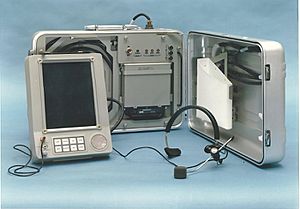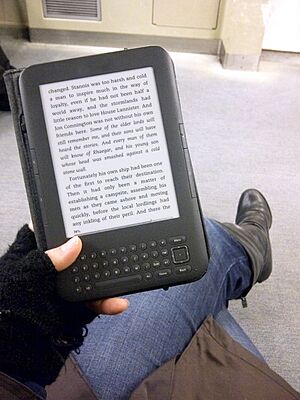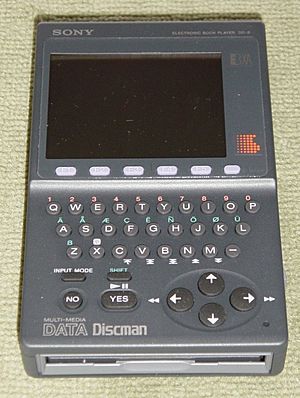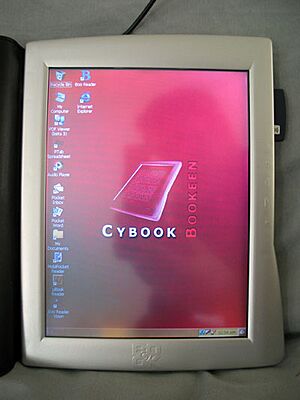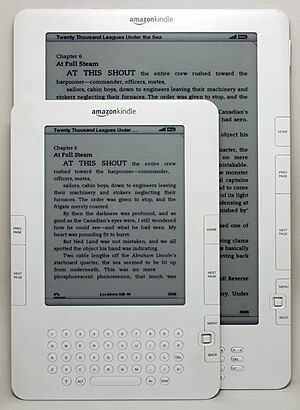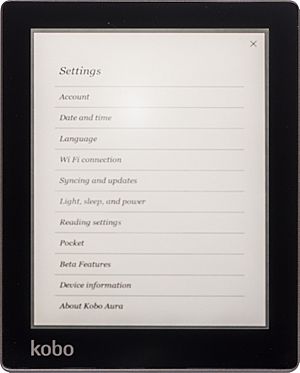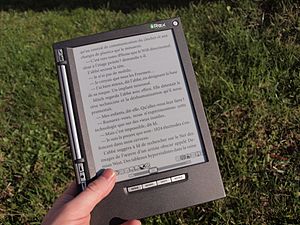E-book facts for kids
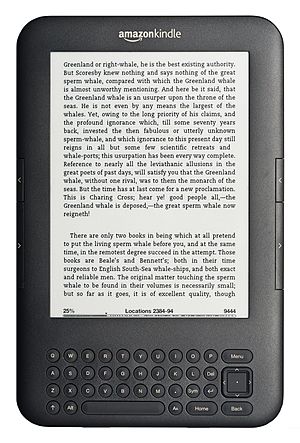
An electronic book (often called an e-book or ebook) is simply a book in digital form. You can read e-books on computers or other electronic devices. These devices include special e-book readers, like the Amazon Kindle, which are made just for reading digital books.
Contents
How E-books Started
E-books have a longer history than you might think! One of the very first digital texts was created in the late 1940s by Roberto Busa. He made a huge index for the works of Thomas Aquinas.
However, many people say the true inventor of the e-book was Michael S. Hart. In 1971, he had a lot of computer time at the University of Illinois at Urbana-Champaign. He used it to type the United States Declaration of Independence into a computer. This was the first electronic document available to many people.
One early idea for an e-book device was the Dynabook in the 1970s. It was a portable computer meant to display books. In 1992, Sony launched the Data Discman. This device could read e-books stored on CDs.
Early e-books were often for special topics or small groups. They included things like technical manuals. But in the 1990s, the Internet became widely available. This made sharing electronic files, including e-books, much easier for everyone.
Early E-book Ideas
After Michael Hart created the first e-book in 1971, he started Project Gutenberg. This project aimed to create digital copies of many more books. Another early idea was the Dynabook in the 1970s. It was a portable computer designed to show books.
In the 1980s, the US Department of Defense worked on a portable device for technical information. It was called the PEAM, or "Portable Electronic Aid for Maintenance."
In 1992, Sony released the Data Discman. This device could read e-books from CDs. One famous e-book for it was called The Library of the Future. As the Internet grew in the 1990s, it became much simpler to share e-books.
Different E-book Formats
Over time, many different e-book formats appeared. Some big companies supported certain formats. For example, Adobe introduced its PDF in 1993. Different e-readers often used only one format. This made it harder for e-books to become popular.
In the late 1990s, a group came together to create the Open eBook format. This was a way for authors and publishers to make one file that many e-readers could use. This format led to the popular EPUB format we use today. Google Books has turned many old books into this open format.
By 2010, e-books were growing in special online markets. Many publishers started sharing books that were in the public domain (meaning they are free to use). Also, authors whose books weren't picked up by traditional publishers could share their work online. Today, a few big publishers control most of the e-book market in the U.S.
E-books in Libraries
US libraries started offering free e-books in 1998. At first, these were mostly academic or technical books. They couldn't be downloaded. By 2003, libraries began offering popular fiction and non-fiction e-books that people could download. This made e-book lending much more successful.
From 2005 to 2008, libraries saw a 60% increase in their e-book collections. By 2010, most public libraries in the US offered e-books. This showed that e-books were becoming very popular.
However, some publishers worry about e-book lending. They are concerned about copying and how it affects sales. Libraries often have to pay much more for an e-book license than a regular person would. This is because publishers fear that one e-book could be read by many people, which might hurt their sales of printed books.
Storing E-books Safely
The Internet Archive and Project Gutenberg offer millions of free e-books. These are mostly books that are in the public domain. This means anyone can read them for free.
E-readers and Apps
An e-reader is a small electronic device made mainly for reading e-books. It looks like a tablet but is designed for reading. E-readers are often better for reading than tablets. They are easy to carry, work well in sunlight, and have long battery life.
In 2010, Amazon.com reported that its e-book sales for the Amazon Kindle were higher than hardcover book sales. By 2011, e-book sales at Amazon even passed paperback sales. In the US, e-book sales passed hardcover sales for the first time in 2012.
Until 2013, you couldn't use e-readers on airplanes during takeoff and landing. But now, the FAA allows them if they are in "Airplane Mode." Experts predicted that by 2018, e-books would make up over half of all book sales in the US and UK.
E-reader Apps
Many major book stores and other companies offer free e-reader apps. You can use these apps on computers, phones, and tablets. This means you don't need a special e-reader device to enjoy e-books. Examples include apps for the Amazon Kindle, Barnes & Noble Nook, iBooks, and Kobo eReader.
E-book Timeline
Let's look at some important moments in e-book history:
Until 1979
- Around 1949: Ángela Ruiz Robles in Spain patented an idea for an electronic book.
- 1971: Michael S. Hart typed the United States Declaration of Independence into a computer. He then started Project Gutenberg to create more e-books.
- 1978: The Hitchhiker's Guide to the Galaxy radio series imagined an electronic book that held all knowledge.
1980–1999
- 1989: Project Gutenberg released its 10th e-book.
- 1992: Sony launched the Data Discman e-book player.
- 1993: Peter James published his novel Host on floppy disks. It was called the "world's first electronic novel."
- 1994: E-books started to be published in HTML format instead of plain text.
- 1996: Project Gutenberg reached 1,000 titles.
- 1997: E Ink Corporation was started to create "electronic ink." This technology is now used in many e-reader screens.
- 1998: NuvoMedia released the Rocket eBook, one of the first handheld e-readers.
- 1999: The NIST released the Open eBook format. This format became the basis for many future e-book types.
2000s
- 2000: Stephen King released his story Riding the Bullet only online. It sold 500,000 copies in two days!
- 2004: Sony released the Sony Librie, the first e-reader with an E Ink display.
- 2004: Google announced plans to digitize many library books for the Google Books Library Project.
- 2007: The International Digital Publishing Forum released EPUB, which replaced Open eBook.
- 2007: Amazon.com released the Kindle e-reader. It sold out in just 5.5 hours!
- 2009: Barnes & Noble released the Nook e-reader.
2010s
- 2010: Apple released the iPad with its own e-book app, iBooks.
- 2010: Amazon reported that e-book sales were higher than hardcover sales for the first time.
- 2011: Amazon.com announced that its e-book sales in the US were now higher than all its printed book sales.
- 2012: E-books sold in the US made over three billion dollars in revenue.
- 2012: Apple released iBooks Author, a tool to create e-books for the iPad.
- 2013: The Association of American Publishers announced that e-books made up about 20% of all book sales.
- 2014: Amazon launched Kindle Unlimited, an e-book and audiobook subscription service.
- 2014: Kobo Inc. released the Aura H₂0, the first waterproof e-reader.
- 2015: By the end of 2015, over 70 million e-readers had been shipped worldwide.
- 2016: Amazon released the Kindle Oasis, a very light e-reader with physical page turn buttons.
- 2016: By the end of 2016, more people were reading e-books on smartphones and tablets than on e-readers. Also, sales of paper books were higher than e-book sales.
- 2017: Sales of physical books continued to grow in the UK, sometimes being cheaper than digital versions. Hardcover book sales were higher than e-books for the first time in five years.
E-book Formats
Writers and publishers can choose from many e-book formats. Each format has its own good points and bad points. Here are some popular e-readers and the formats they can read:
| Reader | E-book formats it reads |
|---|---|
| Amazon Kindle and Fire tablets | AZW, AZW3, KF8, non-DRM MOBI, PDF, PRC, TXT |
| Barnes & Noble Nook and Nook Tablet | EPUB, PDF |
| Apple iPad | EPUB, IBA (books made with iBooks Author), PDF |
| Sony Reader | EPUB, PDF, TXT, RTF, DOC, BBeB |
| Kobo eReader and Kobo Arc | EPUB, PDF, TXT, RTF, HTML, CBR (comic), CBZ (comic) |
| PocketBook Reader and PocketBook Touch | EPUB DRM, EPUB, PDF DRM, PDF, FB2, FB2.ZIP, TXT, DJVU, HTM, HTML, DOC, DOCX, RTF, CHM, TCR, PRC (MOBI) |
Digital Rights Management (DRM)
Many e-book publishers use something called digital rights management (DRM). This is meant to stop people from illegally copying e-books. However, DRM can sometimes stop the person who bought the e-book from accessing it later. E-books from big companies like Amazon.com, Google, Barnes & Noble, Kobo Inc., and Apple Inc. often have DRM. This means they are tied to that company's e-reader or app.
Some publishers, like Tor Books (a big science fiction publisher), decided not to use DRM. Smaller e-book publishers like O'Reilly Media and Baen Books had already stopped using it.
How E-books Are Made
Some e-books are made at the same time as their printed versions. But often, e-books are created from existing paper books. This is done by scanning the pages. Sometimes, special robots are used to scan books quickly without harming them. The scanned images can then be turned into text using a program called OCR.
Sometimes, a publisher might only make an electronic version of a book. It's even possible to release an e-book chapter by chapter as it's being written. This is helpful for fast-changing topics like information technology. You can also turn an e-book into a printed book using Print on demand.
What E-readers Know About Your Reading
E-readers and reading apps can track your reading habits. They can know which e-books you open, how long you read them, and how much of each e-book you finish. For example, in 2014, Kobo shared data from its users. It showed that only about 44% of UK readers finished the popular e-book The Goldfinch. This suggests that while popular e-books are read, some are only started.
E-books vs. Printed Books
Good Things About E-books
An e-reader can hold thousands of e-books in the space of just one physical book. This depends on its memory. Many e-readers have a built-in light, so you can read in the dark. You can also change the font size or type. Some e-readers can even read the text aloud, which is great for people with dyslexia or vision problems.
E-readers also let you look up words or find more information instantly using an online dictionary. Amazon says that 85% of its e-book readers look up a word while reading. E-book apps often have helpful tools like search, links, notes, and interactive features for students.
Making printed books uses more raw materials and water than making e-books. While an e-reader costs more than a single book, e-books themselves can be cheaper than paper books. Many e-books are even available for free online, for example, on Project Gutenberg. All books printed before 1923 are in the public domain, so their e-book versions are free.
If you have DRM-free e-books, you can back them up. If your device breaks, you can download a new copy without paying again. You can also sync your reading progress across different devices.
Things That Aren't So Good About E-books
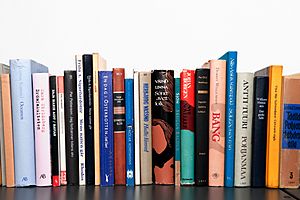
One concern with e-books is privacy. Companies like Amazon might know what you're reading, how long you spend on each page, and what you highlight.
Many people also love printed books as objects. They enjoy the feel, smell, weight, and look of a book on a shelf. Printed books are also seen as important cultural items. Kobo found that 60% of e-books bought from their store are never opened. They also found that more expensive e-books are more likely to be opened.
Writer Joe Queenan shared his thoughts on e-books:
Electronic books are great for people who care about the information in them, or who have trouble seeing, or who like to read on the subway, or who don't want others to see what they're reading, or who have storage problems. But they aren't useful for people who truly love physical books. Books we can touch, smell, and rely on.
While paper books can be damaged by water or stolen, e-book files can also be corrupted, deleted, or lost. Also, with DRM, you might lose access to an e-book if the company goes out of business or if there are copyright issues.
Images for kids
-
Reading an e-book on an e-reader.
-
Michael S. Hart (left) and Gregory Newby (right) of Project Gutenberg, at a conference in 2006.
See also
 In Spanish: Libro electrónico para niños
In Spanish: Libro electrónico para niños


